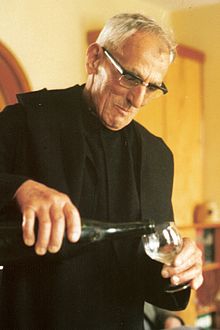Buckfast bee
| Buckfast bee | |
|---|---|
 |
|
| A Buckfast honey bee hive. | |
| Scientific classification | |
| Kingdom: | Animalia |
| Phylum: | Arthropoda |
| Class: | Insecta |
| Order: | Hymenoptera |
| Family: | Apidae |
| Genus: | Apis |
| Species: | A. mellifera - hybrid |
| Karl Kehrle ("Brother Adam") | |
|---|---|

1991 photo
|
|
| Born |
28 August 1898 Mittelbiberach, Germany |
| Died | 1 August 1996 (aged 97) Buckfast, Devon, England, UK |
| Fields | Apiculture |
| Known for | Developer of the Buckfast bee |
| Notable awards | Order of the British Empire, German Bundesverdienstkreuz |
The Buckfast bee is a strain of honey bee. It is a man-made bee race, a cross of many strains of bees, developed by "Brother Adam", (born Karl Kehrle on 3 August 1898 in Germany), who was in charge of beekeeping at Buckfast Abbey in the United Kingdom, where the bees are still bred today. Most of the breeding work in Europe is done by breeders belonging to the breeders association Gemeinschaft der Europäischen Buckfastimker. This organisation is maintaining a pedigree for Buckfast bees, originating from Brother Adam's years.
In the early 20th century, bee populations were being decimated by tracheal mites. This condition, later called "acarine" disease, after the acarine parasitic mite that invaded the bees' tracheal tubes and shortened their lives, was killing off thousands of colonies in the British Isles.
In 1916, only 16 surviving colonies were left in the abbey. All of them were either pure Ligurian (Italian) or of Ligurian origin, hybrids between Ligurian and the English black bee A. m. mellifera. Brother Adam also imported some more Italian queens. From these he began to develop what would come to be known as the Buckfast bee.
The Buckfast contains heritage from mainly A. m. ligustica (North Italian), A. m. mellifera (English), A. m. mellifera (French), A. m. anatoliaca (Turkish) and A. m. cecropia (Greek). The Buckfast bee of today also contains heritage from two rare and docile African stocks A. m. sahariensis and the A. m. monticola, but not the "Africanized" A. m. scutellata. "
Brother Adam was inspired about the survival of the Italian × black bee crosses. To be able to control the matings, he started to use the isolated valley of Dartmoor. With no other bees within range, Brother Adam could maintain their genetic integrity and develop desirable traits. Brother Adam investigated various honey bee races and made many long journeys in Europe, Africa, and the Middle East, searching for pure races and interesting local stocks. The book In Search of the Best Strains of Bee tells about his travels in search of genetic building blocks. Brother Adam imported more bees to cross with his developing Buckfast bee.
...
Wikipedia
